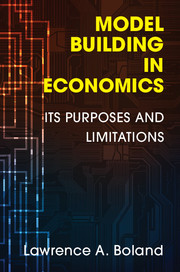Book contents
- Frontmatter
- Dedication
- Contents
- Preface
- Acknowledgements
- Prologue: Model building yesterday versus today
- Part I Theoretical Models
- Part II Empirical Models
- Part III Testing and Models
- Part IV Methodological Considerations
- 11 Model building from a philosophy of science perspective
- 12 Choosing model-building methods
- Epilogue: Against putting ideology ahead of realism
- Bibliography
- Name index
- Subject index
12 - Choosing model-building methods
Published online by Cambridge University Press: 05 October 2014
- Frontmatter
- Dedication
- Contents
- Preface
- Acknowledgements
- Prologue: Model building yesterday versus today
- Part I Theoretical Models
- Part II Empirical Models
- Part III Testing and Models
- Part IV Methodological Considerations
- 11 Model building from a philosophy of science perspective
- 12 Choosing model-building methods
- Epilogue: Against putting ideology ahead of realism
- Bibliography
- Name index
- Subject index
Summary
Macroeconomic model builders always face a choice of how to go about building models, although far too many North American model builders are unaware of the options. There are many reasons for the lack of awareness, but they fall into three categories: sociological, historical and methodological. Few graduate students are given any training in how to go about choosing a modeling method. Instead, they are encouraged to follow their teachers’ examples of demonstrated successful modeling. Needless to say, for a decade or more the sub-discipline of the history of economic thought has not been considered an essential part of anyone’s graduate economics training; consequently, there has been little opportunity to become of aware of historical debates about the best or most appropriate model building methods. An obvious sociological reason is that beginning professors need to worry about their careers. Which modeling method is chosen will be the one that helps in obtaining tenure and promotions. Today, too often, the criterion employed for such promotion and tenure decisions is the quantity of publications. So, if one were aware of several alternative modeling methods to choose between, clearly it would be sensible (dare we say rational?) to choose the method that will maximize the number of published papers within the time allotted before the next tenure or promotion decision – or perhaps just the next salary decision. Methodology-oriented critics of the lack of awareness of alternatives point to the methodological issue of the unrealism of the models created – in particular, models that are the easiest to publish are often ones that disregard the unrealism of the assumptions of the model. In other words, critics of the methods practiced in North America say that too often convenience is put before the time-consuming problem of building realistic models.
- Type
- Chapter
- Information
- Model Building in EconomicsIts Purposes and Limitations, pp. 232 - 240Publisher: Cambridge University PressPrint publication year: 2014



